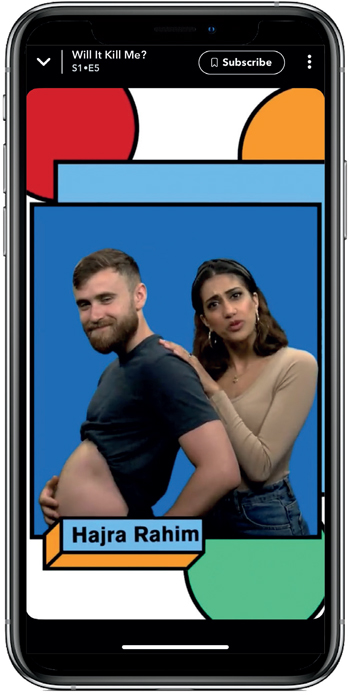
Catch them young
Snapchat regulars will have enjoyed a new video series which began last September, entitled, Will It Kill Me?

Presented by Hajra Rahim and Billy Hodder, the series turned the spotlight on trending health myths and popular misconceptions. One looked at the growing use of fertility apps: Can an app really stop you getting pregnant? (Spoiler alert: if you’re looking to get pregnant, then they can help; if you want to avoid getting pregnant, don’t touch them with a bargepole.)
The four minute episode was light, bright, accessible, entertaining and informative and the tone was spot on for what I imagine was its 16-25 year old target audience.
Perhaps the only surprise was that the video was created by The Telegraph, a newsbrand with an average reader age nearer 60.
Mike Adamson, head of publishing and deputy editor: “It’s fun, informative and shareable, but with a serious intent to examine the many health trends and claims that are shared in the social world.”
Very true, and it’ll certainly be interesting to see how the publisher satisfies the competing and very different needs of its nascent Gen Z audience and its more established baby boomer readership.
Divided Cities
The Guardian has also been busy on the video front, and in November released a new five-part video series, Divided Cities, to mark the thirtieth anniversary of the fall of the Berlin Wall. The series focuses on the divisions facing five global cities today: Melilla, Havana, Nicosia, Memphis and Delhi.
Charlie Phillips, head of video at the Guardian: “Divided Cities uses real-life stories to depict the often invisible forces behind divisions, and makes important links between a diverse group of cities around the world where unexpected kinds of division are making life more complicated.”
The Divided Cities series looks beyond Trump and Brexit to the causes and consequences of global divisions, in a world ever more split between “us” and “them”, say the publishers.
This period also saw the Guardian hit 1 million subscribers on its main YouTube channel. According to the publishers, it now has almost two million total subscribers across its YouTube network, which includes The Guardian (1,000,000), Guardian News (527,000), Guardian Football (134,000) and Owen Jones talks (129,000).
The Guardian’s success on the platform has been driven by a mixture of video formats such as documentaries, explainers and news features. Popular videos include Anywhere but Westminster (1.4m views), The Trap (5.97m), Beyond Bionics (2.36m) and Is Brexit definitely going to happen? (428k).
The publisher’s original series, Modern Masculinity, attracted a younger demographic and achieved some of the highest engagement on the channel, with a total of 1.36m views, 7.25m minutes watched, 66k likes, 10.7k shares and 8k comments.
Christian Bennett, executive editor, visual journalism, said: “We are building a large engaged community around our video journalism and YouTube is enabling us to reach new readers – over half of our audience on the platform is under 34.”
Left field award
The winner of our very occasional ‘Left field’ award – awarded to a publisher for producing something which has absolutely nothing to do with publishing – goes to the Financial Times, for its new, err… board game, Road to Riches.
Aimed at secondary school pupils, the idea is to boost financial literacy; players will have fun while learning to make better financial decisions.

The game was the brainchild of 19-year-old former FT intern and Manchester University student Krishan Puvvada, who wanted to create a way for students to learn about money and investing, and economist and game designer Mario Fischel.
The game pits two or more players against each other. To start building their future wealth, players have to bet on questions about financial matters and the economy. Then they must decide what to do with the money they have amassed – including investing in their own education, saving for retirement and buying or renting a home. The winner is the first to achieve all of these milestones without going bust.
During the testing period, Krishan also challenged Lionel Barber, FT editor, and Robert Shrimsley, the FT’s editorial director, to a game. “I dare not divulge whether they beat the interns, but I can confirm that they both knew the definition of inflation,” he said.
“The object is to make discussions about money fun and exciting and we tested the game extensively in schools across the UK to make sure,” said Krishan. “Surprisingly, not one student looked at their phone during the testing. They were all completely immersed and invigorated by this old-fashioned concept of a board game.”
The Financial Times will send the Road to Riches game free of charge to all UK secondary schools that are part of the FT Schools initiative.
Ditching polywrap
The latest publications to ditch plastic wrap include BMJ, The Sun and BBC Gardeners’ World and the publishers are feeling good about their decision:
“We realise that if The BMJ is to advocate for more sustainable healthcare we must continuously work to get our own house in order,” said a BMJ spokesperson.
News UK retail director Neil Spencer: “This latest plastics move means News UK is now well on the way to removing 800 tonnes of plastic from the supply chain by 2020. We know readers and retailers have responded very positively to these changes on The Times and The Sunday Times and we are glad that The Sun is also now able to phase out its plastic inner polybagging.”
Lucy Hall, BBC Gardeners’ World editor: “Posting all our subscriber copies in paperwrap significantly cuts our plastic use, which we know is incredibly important to our readers. This step also reflects the magazine’s ethos of improving the environment and benefitting the world around us.”
Marie Claire goes ‘digital-first’
In September, TI Media announced that Marie Claire was going “digital-first”, which is another way of saying that they are closing its print edition.
According to TI Media, this represents a significant evolution for the premium fashion and beauty brand, that will enable it to best serve the changing needs of its audience’s mobile-first, fast-paced, style-rich lifestyles.

CEO Marcus Rich: “The success of Marie Claire Edit and Fabled by Marie Claire are good examples of how, at TI Media, we can extend our unrivalled content and expertise into the digital space. There is enormous potential for us to drive our ongoing transformation through growing our digital business quickly and it will continue to be a key focus for us.”
TI Media is, understandably, dressing this up as an exciting more, and the logical next step for the brand. But something has died. The brand has lost its flagship.
Marie Claire’s long standing editor-in-chief and managing director, Trish Halpin and Justine Southall respectively, have left the company and the challenge for their replacements is to keep the brand’s distinctive personality alive with less resource and a lower market profile. To survive and thrive, the title needs to avoid becoming just another shopping channel.
And, there’s likely to be little respite online, where the competition is just as fierce and coming from all directions, not least from new kid on the fashion block: Buro 24/7.
The brand has been putting together a heavy hitting editorial team over the last six months.
On her appointment as editor-in-chief in May, Kate Stephens said: “My aim is to disrupt an increasingly formulaic media landscape with a content proposition that is as innovative as it is impactful... where creativity is fuelled by data, rather than being supplemented by it, and where every pixel produced is delivered with an unwavering commitment to quality, beauty and style.”
Digital director Reena Prashar: “As our brand DNA is to be bold, dynamic, colourful and playful, we’ve empowered the design and editorial teams to execute immersive storytelling as a luxury brand should.”
If the new site lives up to half its hype, then the fashion sector has just become a lot more interesting.
Meet the Clintons
Stylist magazine is continuing to make waves in its tenth anniversary year. In October, the world’s most famous mother and daughter team generously agreed to plug their book – The Book of Gutsy Women – by guesting editing the magazine.
The issue drew on Hillary and Chelsea’s passions and the “gutsy women” that inspired them, including Sally Ride, the first American woman in space, and gynaecologist and campaigner Dr Gao Yaojie.
Lisa Smosarski, editor-in-chief of Stylist magazine, said: “No one has used their platform to change the world more than Hillary Rodham Clinton, who works so hard to help other women. Her daughter Chelsea has also made feminism her mission, writing several empowering children’s books about female icons. In an industry first, they’ve joined together to take over Stylist and create their Gutsy Women issue.”
Hillary and Chelsea added: “We have believed for a long time that ensuring the rights, opportunities and full participation of women and girls remains a big piece of the unfinished business of the 21st century. We’ve made progress, but we still have work to do. We hope this issue will inspire you to think about what you can do – close to home or around the globe – to make sure women everywhere can follow their dreams and live life on their own terms.”
Social media blackout
To mark World Mental Health Day in October, Bauer Media brands called on audiences to ditch social media for one hour.
This followed insight commissioned by Where’s Your Head At? that revealed the worries surrounding the effects of social media on mental health. The research found that 81% agree that social media should be used in moderation.
Bauer Media brands, including Absolute Radio, Grazia, heat, Magic, Closer and Hits Radio, called on their audiences to join them in a social media blackout from 1-2pm on Thursday 10th October. During this time, these brands refrained from posting or commenting and called on audiences to start face to face conversations – hoping to encourage open discussions around mental health in support of Where’s Your Head At?
Sarah Barnes, people and culture director at Bauer: “As a diverse and progressive employer, we are working to ensure parity of treatment for mental and physical health for all of our people. As part of our commitment to Belonging at Bauer, we now have 27 trained mental health first aiders and are working towards having one in every Bauer site. Our work continues to ensure Bauer is a great place to do great work for all.”
My bedtime reading is currently Zucked: Waking up to the Facebook Catastrophe, by Roger McNamee, which is a fascinating insight into the harmful and addictive character traits that are the deliberate side effects of the way social media companies like Facebook have engineered their platforms.
If Bauer’s social media blackout helped raise awareness of the danger that social media has become, then it will have done us all a service.
This article was first published in InPublishing magazine. If you would like to be added to the free mailing list, please register here.










